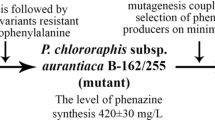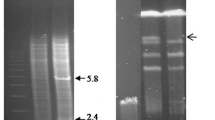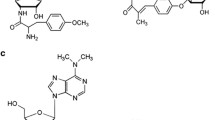Abstract
An insertion mutant of Pseudomonas fluorescens PGPR strain 267.1 was found to be auxotrophic for niacin (nicotinic acid) and could not synthesize quinolinic acid. The Tn5 interrupted gene was cloned and sequenced. The cloned fragment contained an open reading frame, nadA, capable of encoding a 359-amino-acid protein (39.0 kDa) with substantial identity to various bacterial quinolinate synthetases. The nadA gene complemented quinolinic acid synthesis deficiency and niacin auxotrophy of the P. fluorescens 106P nadA mutant.


Similar content being viewed by others
Literature Cited
Deryło M, Skorupska A (1993) Enhancement of symbiotic nitrogen fixation by vitamin-secreting fluorescent Pseudomonas. Plant Soil 154:211–217
Flachmann R, Kunz N, Seifert J, Gütlich M, Wientjes F, Läufer A, Gassen HG (1988) Molecular biology of pyridine nucleotide biosynthesis in Escherichia coli. Cloning and characterization of quinolinate synthesis genes nadA and nadB. Eur J Biochem 175:221–228
Foster JW, Park YK, Penfound T, Fenger T, Spector MP (1990) Regulation of NAD metabolism in Salmonella typhimurium: Molecular sequence analysis of the bifunctional nadR regulator and the nadA-pnuC operon. J Bacteriol 172:4187–4196
Foster JW, Penfound TA (1993) The bifunctional NadR regulator of Salmonella typhimurium: Location of regions involved with DNA binding, nucleotide transport and intramolecular communication FEMS Microbiol Lett 112:179–184
Gerdes SY, Scholle MD, D’Souza M, Bernal A, Baev MV, Farrell M, et al. (2002) From genetic footprinting to antibacterial drug targets: Examples in cofactor biosynthetic pathways. J Bacteriol 184:4555–4572
Holtwick R, Meinhardt, Keweloh H (1997) cis-trans isomerization of unsaturated fatty acids: Cloning and sequencing of the cti gene from Pseudomonas putida P8. Appl Environ Microbiol 63:4292–4297
Kovach ME, Elzer PH, Hill DS, Robertson GT, Farris MA, Roop II RM, Peterson KM (1995) Four new derivatives of the broad-host-range cloning vector pBBR1MCS, carrying different antibiotic-resistance cassettes. Gene 166:175–176
Magni G, Amici A, Emanuelli M, Raffaelli N, Ruggieri S (1999) Enzymology of NAD+ synthesis. Adv Enzymol Relat Areas Mol Biol 73:135–182
Marek-Kozaczuk M, Kopcińska J, Łotocka B, Golinowski W, Skorupska A (2000) Infection of clover plant growth promoting Pseudomonas fluorescens strain 267 and Rhizobium leguminosarum bv. trifolii studied by mTn5-gusA. Antonie van Leeuwenhoek 78:1–11
Marek-Kozaczuk M, Skorupska A (2001) Production of B-group vitamins by plant growth-promoting Pseudomonas fluorescens strain 267 and the importance of vitamins in the colonization and nodulation of red clover. Biol Fertil Soils 33:146–151
Penfound T, Foster JW (1999) NAD dependent DNA-binding activity of the bifunctional NadR regulator of Salmonella typhimurium. J Bacteriol 181:648–655
Rovira AD, Harris IR (1961) Plant root excretion in relation to the rhizosphere effect. V. The exudation of B-group vitamins. Plant Soil 19:199–211
Saitou N, Nei M (1987) The neighbor-joining method: A new method for reconstructing phylogenetic trees. Mol Biol Evol 4:406–425
Sambrook J, Fritsch EF, Maniatis TA (1989) Molecular cloning: A laboratory manual, 2nd edn. Cold Spring Harbor, NY: Cold Spring Harbor Laboratory Press
Simon R, Priefer U, Pühler A (1983) A broad host range mobilization system for in vivo genetic engineering: Transposon mutagenesis in Gram-negative bacteria Biotechnology 1:784–791
Vincent JM (1970) A manual for the practical study of the root-nodule bacteria. Oxford: Blackwell Science
Zhu N, Olivera BM, Roth JR (1991) Activity of the nicotinamide mononucleotide transport system is regulated in Salmonella typhimurium. J Bacteriol 173:1311–1320
Author information
Authors and Affiliations
Corresponding author
Rights and permissions
About this article
Cite this article
Marek-Kozaczuk, M., Rogalski, J. & Skorupska, A. The nadA gene of Pseudomonas fluorescens PGPR strain 267.1. Curr Microbiol 51, 122–126 (2005). https://doi.org/10.1007/s00284-005-4553-2
Received:
Accepted:
Published:
Issue Date:
DOI: https://doi.org/10.1007/s00284-005-4553-2




